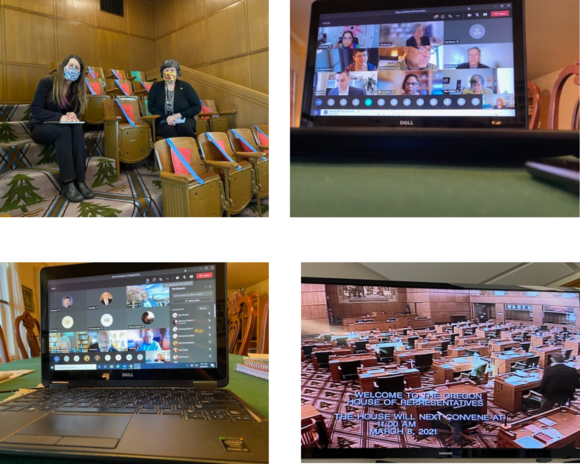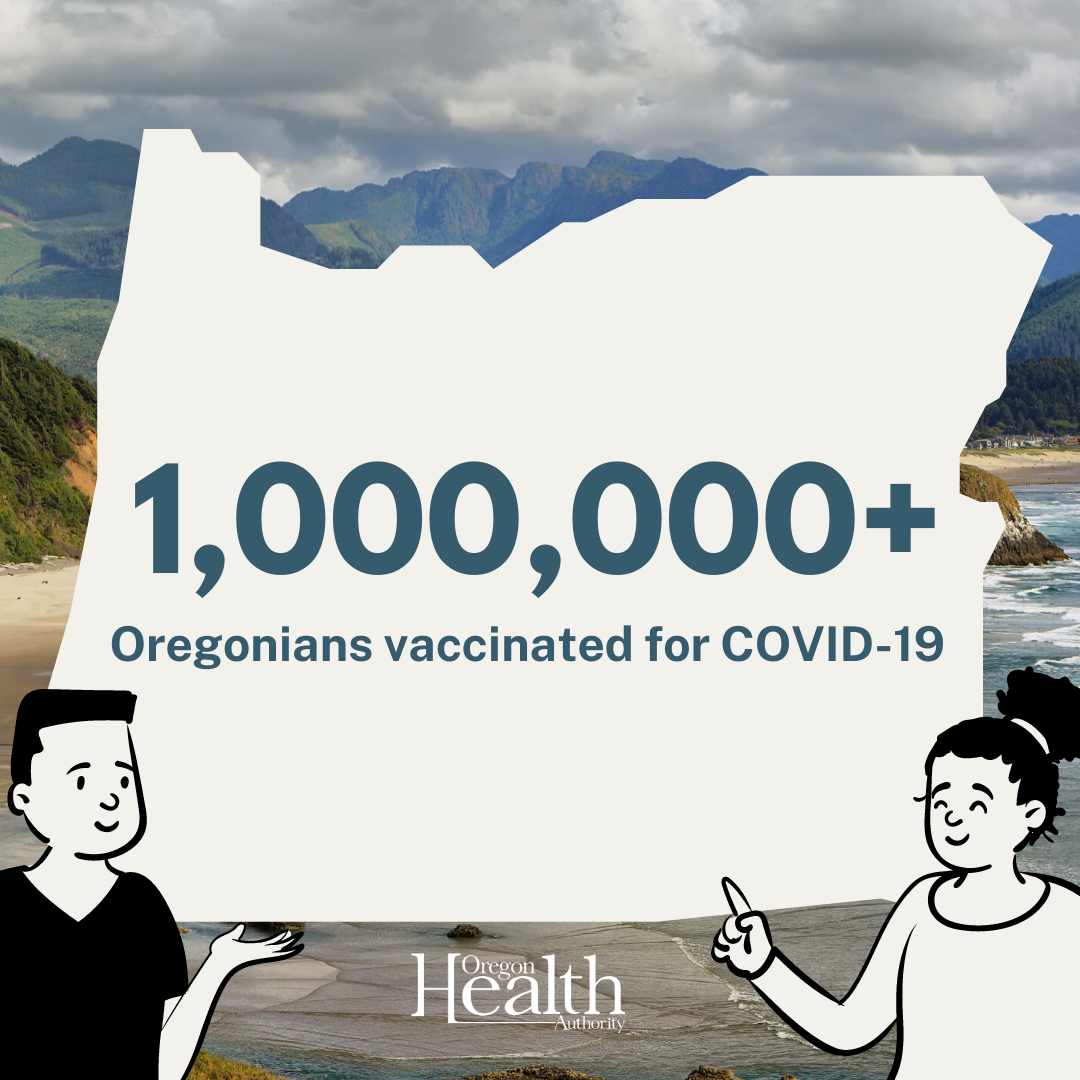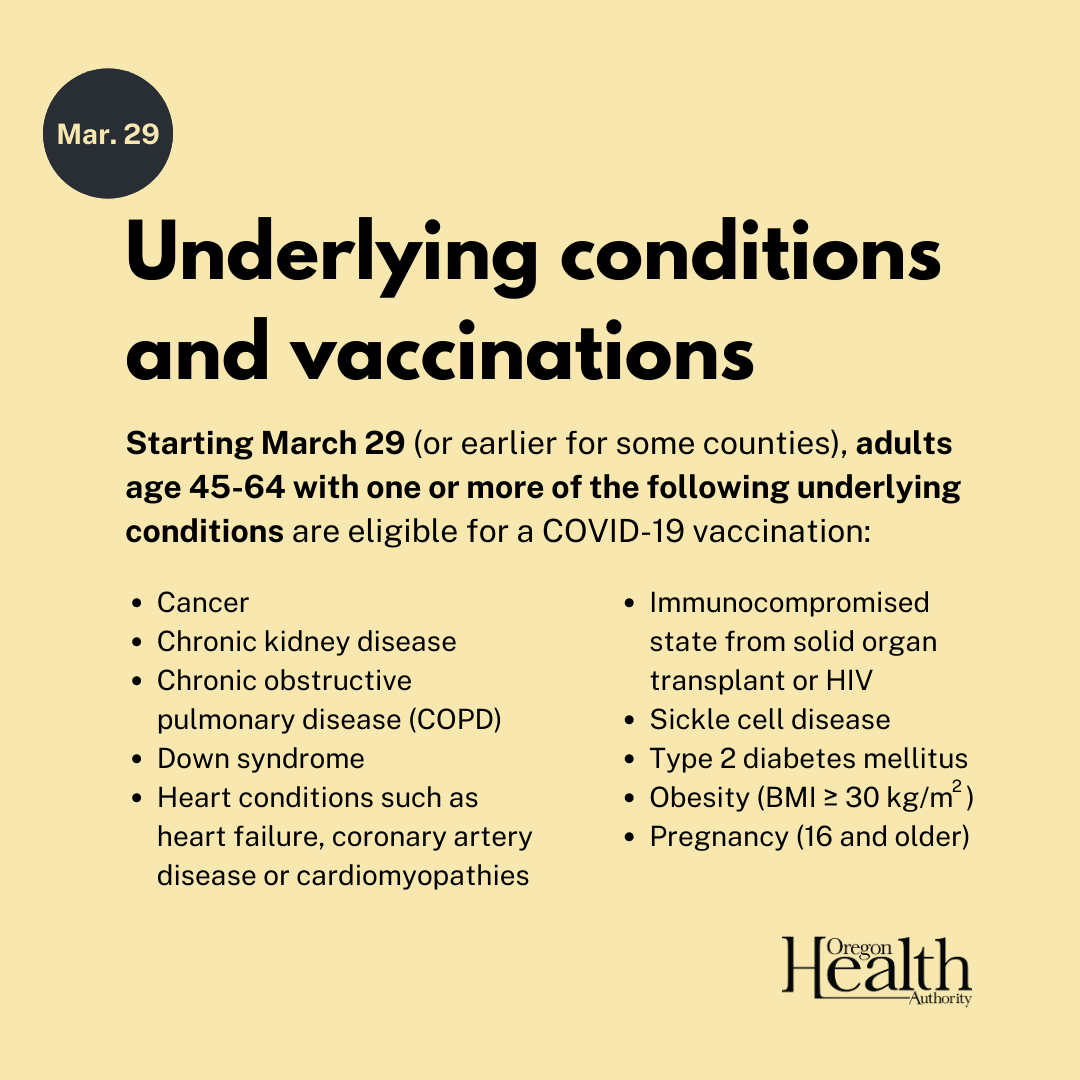|
Hello Friends,
This week there have been regular committee meetings, hearings and work sessions on bills, budget conversations, and amendment work. We are looking for legislation that can support our communities and give workable policies for high priority areas of need. We will update some of the bills from our office and top priorities for 2021 below.
2021 Session Committee Assignments
Joint Committee On Ways and Means
Joint Committee On Transportation - Co-Chair
House Committee On Agriculture and Natural Resources
Joint Committee On the Interstate 5 Bridge - Co-Chair
Joint Committee On Ways and Means Subcommittee On Education - Co-Chair
2019-2020 Joint Emergency Board
Watch all Oregon State Legislature Live-Streams and Meetings HERE
Track all 2021 Session Bills HERE

Transportation Accessibility Bill (HB 2985) - Getting around your community when you have mobility issues can be a challenge. This bill directs the Oregon Department of Transportation to require that all committees and boards advising ODOT or relating to physical mobility, have a member with a disability. In order for all Oregonians to have meaningful access to mobility opportunities that are vital to health, prosperity and well-being, we need our policies to be informed by all groups of Oregonians. The lack of representation from people with mobility issues has had real effects on the health and well-being of people in that community. Increasing representation on advisory groups will help ODOT and other agencies live up to their goals and values.
Update: Passed out of the Joint Transportation Committee unanimously with strong bi-partisan support. The bill is now headed to the House floor.
Part Time Faculty Healthcare Bill (HB 3007) - Part-time faculty at Oregon Universities and Community Colleges do not have access to healthcare benefits. Many part-time faculty in Oregon teach enough total hours that they should qualify for state health care coverage under current requirements, but the simple fact that they teach at multiple institutions disallows them from coverage even though their colleagues who teach the same amount at one institution receive coverage. HB 3007 provides access to health care coverage under OEBB for part-time faculty who qualify for PERS (600-1800 hours of work in a year) and teach more than a half-time course load, whether at one institution or multiple.
Update: Passed out of the House Committee on Healthcare unanimously with strong bi-partisan support. The bill is now headed to the Joint Committee on Ways and Means.
Community-Based Structured Housing Bill (HB 2953) - The Community-Based Structured Housing Fix bill ensures adequate oversight of community mental health programs. This bill would close the loophole that has allowed some mental health facilities to NOT register with the state, which leaves our medically vulnerable population in unsafe and unmonitored environments - environments that are intended to support them.
Update: Passed out of the House Committee on Housing with unanimously with strong bi-partisan support. The bill is now headed to the House floor for vote.
Congratulations to Anne Lane, who has recently been hired as Forest Grove’s new director of parks, recreation and aquatics. Welcome to the new role, Anne! |
|
 |

Also, a big thank you to Tom Gamble, who retired at the end of January after 32 years of continuous service and nearly 50 years of cumulative experience with our city.
|
Governor Kate Brown Announces Accelerated Timelines for COVID-19 Vaccination
*This announcement is from Governor Kate Brown’s Press Release. Click the link above to read more.
- Governor Kate Brown today announced that, in light of increasing vaccine supplies from the federal government and the progress counties and health care providers have made vaccinating seniors, Oregon will again be accelerating its timelines for COVID-19 vaccine eligibility for frontline workers and people with underlying health conditions.
- In the past week, after attesting to largely completing senior vaccinations, 22 counties have begun vaccinating Oregonians in Phase 1B, Group 6. On Monday, March 29, Oregonians statewide in Group 6 will become eligible for vaccination, as previously scheduled.
- Beginning Monday, April 5, all people in Phase 1B, Group 7 will become eligible for vaccination, two weeks earlier than previously planned. As previously announced, all Oregonians over the age of 16 will become eligible for vaccination no later than May 1.
→ Phase 1B, Group 6 (No later than March 29)
- Adults 45-64 with underlying health conditions,
- Migrant and seasonal farm workers,
- Seafood and agricultural workers,
- Food processing workers,
- People living in low-income senior housing, senior congregate and independent living,
- People experiencing homelessness,
- People currently displaced by wildfires,
- Wildland firefighters, and
- Pregnant people 16 and older.
→ Phase 1B, Group 7 (April 5)
- Frontline workers as defined by the CDC,
- Multigenerational household members, and
- Adults 16 and older with underlying health conditions.

Oregon hits another milestone: 1 million people vaccinated
*This announcement is from the Oregon Health Authority Press Release.
-
Good news: More than 1 million Oregonians have now gotten at least one dose of COVID-19 vaccine, the Oregon Health Authority announced on Wednesday.
-
Eligible residents in every county have been vaccinated, as Oregon continues to make steady progress in ensuring all Oregonians who wish to be vaccinated have that opportunity.
-
As Oregon continues its vaccine rollout, please keep taking protective measures to help keep yourselves, your families, coworkers, loved ones, friends and communities safe and healthy.
-
OHA's dashboards provide regularly updated vaccination data, and Oregon’s dashboard has been updated today.
-
Learn more in today’s press release.

People 45-64 with underlying conditions eligible for vaccination by next week
*This announcement is from the Oregon Health Authority Press Release.
- As you know, Oregon is doing vaccinations in phases. Many new groups of people become eligible no later than March 29.
- One of these is people aged 45-64 who have one or more of the underlying health conditions listed on the graphic below.
- According to the Centers for Disease Control and Prevention (CDC), people with these conditions are at increased risk of severe illness from COVID-19. Oregon has made two changes to the CDC list: The state is not including smoking (but is including smoking-related illnesses) and has added HIV.
- What to know when you go for your vaccination:
- You will not need to show proof of an underlying condition.
- People 45-64 with any kind of cancer are eligible no later than March 29. If your cancer is in remission (and you aren’t eligible under any other category) you’ll be able to get vaccinated starting no later than May 1.
- Check eligibility dates in your county. Some counties have started vaccinating people with underlying conditions before March 29.
Are you pregnant and wondering about vaccination?
*This announcement is from the Oregon Health Authority Press Release.
- By March 29 at the latest, pregnant people 16 and older in Oregon will be eligible to be vaccinated. This is because, although overall risk is low, pregnant people are at higher risk for severe illness from COVID-19, and people who get COVID-19 during pregnancy may be at more risk of preterm birth.
- Here’s what you need to know about pregnancy and the vaccine:
- We don’t yet have much data about the safety of the three authorized vaccines for people who are pregnant. But based on how the vaccines work, experts believe they are unlikely to pose a specific risk to people who are pregnant.
- Pregnant people haven’t reported different side effects from non-pregnant people. If you get a fever after vaccination, you can take acetaminophen because fever during pregnancy has been linked to negative outcomes.
- Vaccines have not been studied in people who are breastfeeding. However, experts think that the COVID-19 vaccines are not a risk for them or for their babies.
- There is no evidence that any vaccines, including COVID-19 vaccines, cause fertility problems. You can get a COVID-19 vaccine if you are trying to get pregnant now or want to get pregnant in the future.
- And of course, if you have questions, it can help to talk through your decision with your doctor.
- Learn more about pregnancy and COVID-19 vaccination here.
 |
Update your information in Get Vaccinated Oregon
*This announcement is from the Oregon Health Authority Press Release.
- With more people becoming eligible for COVID-19 vaccination on Monday, March 29, the Get Vaccinated Oregon (GVO) tool is now updated with questions about the new eligibility groups. We encourage everyone who has signed up but not yet gotten a vaccine to update their information.
- If you’ve signed up for notifications only, please update your information by visiting getvaccinated.oregon.gov and clicking “Get Started.”
- If you created a Get Vaccinated Oregon profile, please visit getvaccinated.oregon.gov and click “Login” in the top right of the page. When you get a pop-up, click the “X” and you’ll be able to log in and update your information.
→ Here are some things to know about the GVO:
- If you update your info this week but won’t be eligible until March 29, the tool will say you are ineligible. This will automatically update on March 29 if you become eligible.
- The GVO tool reflects statewide eligibility only. It does not take into account the counties that have been approved to move ahead of the statewide timeline.
- If you haven’t yet received a COVID-19 vaccine, it’s a good idea to sign up for the GVO tool.
National Numbers:
- Confirmed Cases: 29,834,734
- Deaths: 542,584
-
These national numbers come from the Centers for Disease Control and Prevention. You can view their national and state by state data here.
Oregon Status Report:
- Oregon now has 163,000 total cases (confirmed and presumptive) of COVID-19.
- Today we have 422 new confirmed and presumptive cases, and 2 new deaths.
- A total of 2,138 Oregonians have died from COVID-19.
(previous daily case updates from OHA here)
- Washington County still has one of the highest case counts at 22,053 confirmed cases, including 221 deaths. You can review on-going updates from OHA by clicking on the table below.
The Oregon Health Authority recently provided a Public Health Indicators Dashboard to enable communities across Oregon to monitor COVID-19 in the state.The dashboard, which will be updated weekly on Thursdays, provides a transparent report that presents complex epidemiological data in an interactive, easy-to-understand way on a state and county level.
Are your sniffles seasonal allergies or COVID-19?
*This announcement is from the Oregon Health Authority Press Release.
- Have you had the sniffles lately?
- It is allergy season, but you may be wondering how to tell if it’s allergies or COVID-19. The Centers for Disease Control and Prevention made a graphic that might help answer that question. Because some of the symptoms of COVID-19 and seasonal allergies are similar, it may be difficult to tell the difference between them, and you may need to get a test to confirm your diagnosis.
Forest Grove School Opening Update:
Grades PK-6th grade will start school on April 5th. On March 29th-31st, PK-6th teachers will be transitioning back to their classrooms in preparation for the return to school. As a result, there is no school for all PK-6th grade students. Our 7th-12th grade students will continue in CDL until the beginning of hybrid instruction on April 19th.

Forest Grove to receive $5.2 million in ARP aid
- Relief is coming for Forest Grove, said Mayor Pete Truax of the passage of the American Rescue Plan Act.
- The $1.9 trillion economic relief package was approved by Congress and signed into law by President Joe Biden in early March. Among the relief it provides is direct assistance to cities, including Forest Grove, where local officials estimate about $5.2 million to come from the legislation over a two-year period.
- Truax spoke to the help that ARP will provide people nationwide, but also specifically spoke to the benefit Forest Grove will see from the federal aid.
- The first of two money distributions will arrive in roughly 90 days, with the second arriving a year later.
- Funds can be designated in the following ways:
- Responding to the COVID-19 public health emergency
- Providing premium pay to essential workers
- Offsetting lost revenues to provide essential government services
- For water, sewer and broadband infrastructure
|
Wildfire Debris Cleanup
5 things to know about wildfire debris and hazard tree removal this month
-
Pace and scale continues to ramp up. Once hazardous materials and waste were removed during the fall and winter of 2020, crews began the process of removing debris from nearly 3,000 home sites and marking and removing more than 290,000 hazard trees starting in January 2021. Two months in, steady progress continues on track with the initial 6-18 month timeline, with sites being completed at various times within this window as crews move to new areas. Given the extreme need, we know that no pace will ever be fast enough, but we’re pushing hard for Oregon.
-
You can track cleanup status any time. Follow along and track what’s happening in your community through our interactive status map and data dashboard (scroll down the page to view). Data can also be tracked by each fire area. For offline options or questions about how to navigate the site, our hotline is available at 503-934-1700.
-
It’s time to submit your Right of Entry agreement, if you haven’t already. We want to ensure that everyone who had property damaged in the fires has the opportunity to participate in our program. So that crews can plan ahead and mobilize to future sites efficiently, please submit your Right of Entry agreement before or as work starts in your area.
-
Take a moment to double-check that your private property questionnaire aligns with local building codes. If you’ve chosen to remove debris yourself, know what’s required before rebuilding. Sometimes the debris removal requests we receive are not aligned with local rebuilding requirements. For example, local codes may have very specific requirements for the condition of home foundations before someone can rebuild. We suggest working with local governments to learn more. If you’ve chosen to remove debris yourself—to ensure your safety and health—please be aware of what’s required before starting.
-
We’re here to help, Oregon. We’re humbled and honored to be able to help during this challenging chapter in Oregon history. We’re all in this together. #OregonRising
Wildfire Debris Cleanup is making progress as weather improves
With warmer, sunnier weather, outdoor activities have increased, providing opportunity to see both wildfire impacts and the great progress made by debris cleanup crews. Work has ramped up with 75 contractor crews on the ground marking and cutting hazard trees, testing for asbestos and cleaning sites to prepare properties for rebuilding.
The majority of sites have been cleared for asbestos, but it is not too late to have your property tested by ODOT. If you have not submitted a Right of Entry form, visit the Oregon Wildfire Cleanup page and click on your county to access the appropriate form.
Working closely with arborists, crews continue to remove hazard trees from public and private property. To date, more than 15,300 hazard trees have been removed and 845 home sites have been cleaned. You can track these numbers along with cleanup status by property address at ODOT's Step 2 Cleanup page.
With Oregonians out and about for Spring Break activities, the public is urged to use caution when traveling and recreating as debris removal crews are working in wildfire impacted areas. Thanks in advance for helping us keep recovery operations moving safely and efficiently.
Wildfire Recovery Resources
OEM has put together this list of contacts to help speed up the process of replacing these documents:
-
Green cards: Phone (800)-375-5283; Website: www.uscis.gov
-
Medicare cards: Phone: (800)-772-1213; (TTY) (800)-325-0778 Website: www.medicare.gov
-
Military records Phone: 866-272-6272 Website: www.archives.gov/contact/
-
Passport Phone: 877-487-2778; (TTY) 888-874-7793 Website: travel.state.gov
-
Social Security card Phone: 800-772-1213; (TTY) 800-325-0778 Website: www.ssa.gov
-
U.S. Savings Bonds Phone: 844-284-2676 Website: www.treasurydirect.gov
-
U.S. tax returns Phone: 800-829-1040 Website: www.irs.gov
-
Birth, death, marriage, domestic partnership, divorce certificates Phone: 888-896-4988 Website: www.oregon.gov/oha/PH/Birthdeathcertificates
-
Driver’s license, auto titles and registration, ID cards Phone: 503-945-5000 Website: www.oregon.gov/odot
-
SNAP (Oregon Trail Card) Website: www.oregon.gov/DHS/Assistance/Food-Benefits
-
State taxes (Oregon Dept. of Revenue) Phone: 503-378-4988 or 800-356-4222 TTY: All relay calls are accepted. Website: www.oregon.gov/dor
-
Real estate and property - Contact your county government.
-
Credit cards - Contact your credit card company directly.
-
Credit reports from Equifax, Experian, TransUnion Phone: 877-322-8228 Website: www.annualcreditreport.com
-
Insurance documents - Check with your insurance agent.
-
Medical records - Call your doctor or your medical insurance company; medical and prescription records are tracked electronically.
The Governor’s office has put together a Wildfire Resources page that you can access from the Governor’s home page. It has links to many of the most important updates about the status of fires and resources for evacuees. This website will be updated regularly.
Legal Resources: Oregon State Bar’s Lawyer Referral Program, Oregon lawyers, through the Oregon State Bar, are partnering with FEMA and the American Red Cross to provide legal assistance on FEMA claims, contract claims, insurance claims, landlord-tenant matters and more.
The Department of Forestry’s Wildfire Response and Recovery Overview has ongoing updates about firefighting efforts, damage reports, and more.
FEMA Updates: FEMA has provided several different Fact Sheets and resources for accessing benefits, determining eligibility and avoiding scams.
Most Oregonians can renew driver license online starting in early May
- Many Oregon residents will be able to renew their driver licenses, permits and identification cards online at DMV2U starting in early May, possibly as early as May 5.
- This new feature coming to DMV2U.Oregon.gov will save thousands of customers a trip to a DMV office and free up appointment times for others. Demand for appointment slots and DMV services remains high because of the COVID-19 backlog.
- When you renew online, you will be able to print a receipt to carry with you. Law enforcement can verify your driving privileges electronically in the event of a traffic stop.
- This online option comes at a critical time. DMV mails renewal reminders to customers about two months before expiration. But many reminders intended to be mailed this winter were delayed by a programming error. Those customers may be eligible to renew online in May faster than waiting for an appointment. News of the online renewal option has been added to the reminders.
Grace period for late renewal
- Oregon residents with a vehicle registration, permit or driver license that expires between Nov. 1, 2020, and April 30, 2021, have up to three months after their expiration date to renew. DMV and Oregon Law enforcement have an agreement that officers will use discretion in a traffic stop when a customer has an expired license or vehicle tag and is within the grace period.
- A bill making its way through the Oregon legislature would grant a six-month grace period from expiration through the end of 2021.
- Also, there is no penalty or extra fee for renewing your driver license, permit or ID card up to 12 months after your expiration date.
What credentials you can renew online starting in May
You will be able to renew your:
- Driver license
- Standard commercial driver license (no endorsements such as hazmat or farm)
- ID card
- Instruction permit
- Motorcycle instruction permit
- Restricted moped-only license
- Disability golf cart driver permit
Online renewal will allow you to make two changes:
- Change your address if you have moved.
- Add or remove the organ donation option from your record.
Who can renew online?
In order to qualify for online renewal:
- Your card must be within 12 months of its expiration date.
- Your previous renewal was done in person at a DMV office.
- You are not suspended or owe a reinstatement fee from a previous suspension.
Vision test waived for drivers age 50 and older renewing online
For the next two years, DMV will postpone the vision test required for drivers age 50 and older who renew online. This will enable more Oregonians to renew online instead of making an appointment at DMV.
Drivers 50 and older who renew online will be required to pass that screening no later than their next renewal.
Find out if you’re eligible online in May
To be certain that you are eligible to renew your current Oregon card online, in early May go to DMV2U.Oregon.gov and start using the online renewal option. It will ask you questions, and if you’re eligible to renew online, you will be able to complete the transaction using a debit/credit card.
More information on accessing DMV services: https://www.oregon.gov/odot/dmv/pages/covid_alert.Aspx
If you plan to travel by air, make sure you have the right ID
If you plan to travel by air in the future, make sure you have what you need to fly within the United States. Starting Oct. 1, you will need a Real ID-compliant form of ID at airport security checkpoints for all flights. Many people already have a Real ID-compliant credential, like a passport or passport card. Find out your best option for air travel ID at Oregon.gov/RealID.
For DMV media inquiries only contact: David House at david.j.house@odot.state.or.us or 503-945-5270.
Jobless benefits flowing to 27,000 Oregon gig workers
- At least 27,000 Oregonians are receiving their first extensions of federal unemployment benefits from the Oregon Employment Department under President Joe Biden's pandemic recovery plan.
- Acting Director David Gerstenfeld says these unemployed workers had exhausted their claims on March 13, but because of the plan — which Biden signed on March 11 — they were able to get renewed benefits for the week starting March 14. The first payments went out this week.
- For people filing new claims for federal benefits — either because they are self-employed or gig workers under Pandemic Unemployment Assistance, or they qualify for up to 25 more weeks under Pandemic Emergency Unemployment Compensation after their 26 weeks of state benefits ended — Gerstenfeld said it may take more time for the agency staff to verify they are eligible. He said because they are federal programs, federal law requires the additional work.
Updates from the Oregon Employment Department:
- Governor Brown’s 10-point Economic Plan
The Employment Department is proud to be a central component of the Governor's 10-point Economic Recovery plan; a key priority in the Governor’s plan is to support every Oregonian whose employment has been impacted by the pandemic.
That means extending the critical unemployment benefits that so many are relying on, and providing the assistance and tools that will allow the unemployed to get back to work.
The devastating impact of the pandemic has disproportionately impacted communities who face economic and other forms of discrimination. OED’s employment services can help the push for racial justice and equity by offering a path to career growth opportunities that arise as our economy evolves during the recovery period.
One example of such a program is the STEP program, which is designed to assist individuals receiving SNAP benefits to obtain skills, training, work experience, and employment to increase their ability to obtain living-wage employment. This program serves as an important service for removing barriers to employment and ensuring more equitable employment opportunities for Oregonians.
OED's Workforce Operations division is working hard to make sure our jobseeker services fit the demands and needs of our new reality. That means partnering with nonprofit organizations and other state agencies, offering virtual services and providing more skills trainings for different occupations that are or will be in demand in specific regions of our state.
Our Research division provides key data and analysis that bolsters the efforts across the department to guide Oregonians back to work. In fact, we are providing data and analysis to support the Governor’s Racial Justice Council in its effort to advance economic prosperity for communities of color. That data also provides quality information for businesses, economists and others so they can make informed choices and help grow our economy.
-
Federal Benefits: American Rescue Plan (ARP)
We are happy to report that we have begun paying benefits for the first week that ARP benefits are available (the week of March 14th) for Pandemic Unemployment Assistance (PUA), Pandemic Emergency Unemployment Compensation (PEUC) and the weekly $300 Federal Pandemic Unemployment Compensation (FPUC) benefits.
The American Rescue Plan provided more benefits, but only allows those new weeks of benefits to be paid for weeks starting March 14, 2021 or later. People who used up their PUA or PEUC benefits before can get the new ARP benefits starting for the week of March 14th. Unfortunately, some people used up their PUA or PEUC several weeks ago and are not eligible for benefits under ARP for those weeks before March 14th.
-
Federal Benefits: Mixed Earner Unemployment Compensation (MEUC)
Now that we’ve begun paying the ARP extensions to the FPUC, PUA, and PEUC programs, we’re shifting our focus to the next item in our priority list: implementing the Mixed Earner Unemployment Compensation program (MEUC), which provides an additional $100 per week for individuals who are receiving Regular UI benefits and had at least $5,000 in self-employment income.
Our goal is to begin paying these benefits by the end of April, including any retroactive benefits for which people are eligible.
We will soon have more information about the MEUC program, including eligibility guidelines and instructions for claimants. Make sure to follow us on social media and sign-up for email updates to stay updated on our progress.
- Spanish-Language Regular UI Application Available
OED’s guiding principles are respect, integrity, and community. And ensuring equal access to our programs is essential to living up to those principles.
Yesterday we launched an online Spanish-language “initial claim” form for those applying for Regular Unemployment Insurance benefits. This is available through our Online Claim System and makes benefits more accessible for Spanish speakers. Press releases for that program are attached.
We are thrilled to be able to provide this service to Oregon workers and are happy to share this news with you.
- Employment/Self-employment Documentation
The Continued Assistance Act (CAA) required that we receive proof of employment or self-employment from everyone applying for, or already receiving, PUA benefits. If people do not provide the required information within a certain timeframe, and the timeframe can vary from claim to claim, the federal government requires us to stop their payments, and to consider some previously paid benefits to be overpayments. As we review submitted documents, we notify claimants whether their provided documents meet federal requirements. More of these notifications will be issued in the days and weeks to come.
We know that the new requirements, and the related deadlines, have been confusing. Earlier this year we created an interactive tool to help people figure out what information they need to provide, and by when. You can find the tool on our ARP page: scroll down to the PUA section and find the “Interactive Tool.”
We understand that there is a lot of conflicting information being circulated about different benefit programs. And as our guidance from the Department of Labor changes, it can be difficult to keep track of what claimants need to do to continue receiving benefits.
The federal deadlines to provide employment documentation are fast approaching. And some people who applied for PUA benefits on or after January 31st have not provided the documentation required by the USDOL.
- In those circumstances, people will receive a decision explaining why they are no longer able to receive PUA benefits and in some cases they will also receive notice of any PUA benefits that are required to be considered overpayments.
- It is very important that people upload their proof of employment/self-employment after logging in to the Online Claim System.
For more information about the PUA proof of employment or self-employment requirement, please visit our PUA FAQs or use our interactive tool.
Our Thursday, April 1st webinar will be in Spanish and will focus on the American Rescue Plan benefit extensions, expired claims, PUA expansion and the new online initial claim application in Spanish.
To register for this webinar and to view all of our past webinars, visit unemployment.oregon.gov/webinars
Our website is always kept up-to-date with information on our programs.
Oregon PUC approves utility programs to assist customers affected by COVID-19
- The Oregon Public Utility Commission has approved debt relief programs to benefit residential customers of investor-owned electric and natural gas utilities with past due balances caused by COVID-19.
- Portland General Electric’s plan was approved on February 11, while the debt relief plans for PacifiCorp, Idaho Power, NW Natural, Avista, and Cascade Natural were approved by the PUC on March 23.
- The debt relief programs must be in place no later than April 1, 2021, with the exception of NW Natural, whose program goes into effect May 3. These programs will be ratepayer funded, following an agreement among a broad group of utilities, stakeholders, and PUC Staff to make one percent of each utility’s 2019 retail revenues in Oregon available for debt relief. This amounts to approximately $39 million in total available funding across the six investor-owned electric and natural gas utilities.
- As of January, there were more than 91,000 customers of investor-owned electric and natural gas utilities who had past-due balances and were more than 90 days behind in paying their energy bills. This is a 252 percent increase when compared to data prior to the pandemic. Additionally, the total amount of past due balances for residential customers has increased to $76.3 million, a 155 percent increase when compared to January 2020.
For a brief description of each utility’s debt relief programs and contact information, visit: https://www.oregon.gov/puc/Pages/Consumer-Information-Center.aspx.
For additional information, contact the PUC at puc.consumer@state.or.us or call 503-378-6600 or 800-522-2404.
Expanded Federal Pandemic Relief Aid Announced for Young People who Experienced Foster Care in Oregon
-
Today, the Higher Education Coordinating Commission’s Office on Student Access and Completion (OSAC) and the Oregon Department of Human Services (ODHS) Child Welfare Division are pleased to announce expanded funds to support progress toward postsecondary education goals for young people who are experiencing or experienced foster care at age 14 or older and who are not yet 27.
-
These funds were included in the bipartisan passage of the 2021 Federal Consolidated Appropriations Act, following foster youth advocacy at the national level. Oregon has flexibility in implementing the services under federal guidance on the fund expansion available through the U.S. Office of the Administration for Children and Families.
-
The pandemic relief aid temporarily expands funding for two programs: the Chafee Educational Training Vouchers (ETV), and the Youth Transitions Program in Child Welfare. The Chafee (ETV) Grants, administered through ODHS in partnership with OSAC, offer funding to support postsecondary education studies to eligible students who hold a high school diploma or GED® credential who are current or former foster children. Typically, the Chafee Grants are available for young people up until age 26 who experienced foster care at age 14 and older, and are available only during an approved registration period. With the new funding, eligible young people could receive a grant up to $12,000 up until age 27. The grant is available to newly eligible students and to students who may have paused their studies due to the pandemic.
-
Eligible students may receive a maximum of $5,000 through the OSAC and financial aid awarding process. Students who are eligible for the expanded Chafee grant of up to $5,000 have been identified and will be contacted by email by OSAC.
-
Additional funds of up to $7,000 per student, administered by the Youth Transitions Program through the Child Welfare Division, have also been expanded to help eligible young people access housing security, transportation costs, and technology needs through the pandemic. These funds will be distributed until exhausted. Students who wish to request the additional funds of up to $7,000 need to contact Youth Transition Programs at ILP.Central@dhsoha.state.or.us.
Rebecca Jones Gaston, Director of the ODHS Child Welfare Division, expressed her optimism about the expansion: “This is important recognition that young people in foster care who may have already aged out, or may be ready to, need extra support for the compounded effects that face this population, especially during COVID-19. We are proud of our staff, partners and community for helping create an Oregon-specific plan to quickly offer assistance.”
Below are the important eligibility changes with the new funding:
-
The age of eligibility for Chafee services under the new law is until a young person turns age 27. Young people (up to their 27th birthday) with a high school diploma or GED® credential and pursuing postsecondary education who experienced foster care when they were age 14 or older and meet other grant eligibility criteria are eligible for Chafee ETV Grant funds.
-
Chafee ETV Grant funds can pay up to $12,000 per student, including costs other than Cost of Attendance, to help students remain in school. Young adults may still be eligible for funds to support their college or training success even if they had to pause their educational plans due to COVID-19. Costs for basic needs like food, housing, transportation, as well as supplies (laptop, internet, etc.) can be covered under this grant.
Students with questions may contact ILP.Central@dhsoha.state.or.us. Questions about the Chafee Grant funding may contact Shannon Donivan-Johns, Deputy Director of OSAC, at 541-517-1085 or shannon.donivan-johns@hecc.oregon.gov.
|
Employers and Employees
 |
 |
 |
 |
 |
Yours truly,
 Representative Susan McLain
House District 29
email: Rep.SusanMcLain@oregonlegislature.gov I phone: 503-986-1429
address: 900 Court St NE, H-376, Salem, OR 97301
website: http://www.oregonlegislature.gov/mclain
|